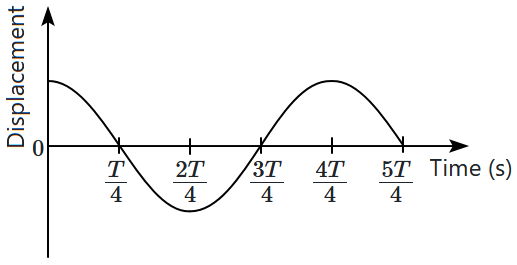The relations between acceleration and displacement of four particles are given below. Which one of the particles is executing simple harmonic motion?
1.
\(a_1 = +2x\)
2.
\(a_1= +2x^2\)
3.
\(a_1= -2x^2\)
4.
\(a_1 = -2x\)
A particle is acted simultaneously by mutually perpendicular simple harmonic motion \(x=a \text{cos}𝜔𝑡\) and \(y = a\text{sin} 𝜔 𝑡\). The trajectory of motion of the particle will be:
1. an ellipse
2. a parabola
3. a circle
4. a straight line
The displacement of a particle varies with time according to the relation, \(y=a~\text{sin} \omega t+b~\text{cos} \omega t.\)
| 1. | the motion is oscillatory but not SHM |
| 2. | the motion is SHM with amplitude \(a+b\) |
| 3. | the motion is SHM with amplitude \(a^{2}+b^{2}\) |
| 4. | the motion is SHM with amplitude \(\sqrt{a^{2}+b^{2}}\) |
Four pendulums \(A,B,C,\) and \(D\) are suspended from the same elastic support as shown in the figure. \(A\) and \(C\) are of the same length, while \(B\) is smaller than \(A\) and \(D\) is large than \(A.\) If \(A\) is given a transverse displacement,

| 1. | \(D\) will vibrate with maximum amplitude. |
| 2. | \(C\) will vibrate with maximum amplitude. |
| 3. | \(B\) will vibrate with maximum amplitude. |
| 4. | All four will oscillate with equal amplitude. |
The figure shows the circular motion of a particle. The radius of the circle, the period, the sense of revolution, and the initial position are indicated in the figure. The simple harmonic motion of the \({x\text-}\)projection of the radius vector of the rotating particle \(P\) will be:

1. \(x \left( t \right) = B\text{sin} \left(\dfrac{2 πt}{30}\right)\)
2. \(x \left( t \right) = B\text{cos} \left(\dfrac{πt}{15}\right)\)
3. \(x \left( t \right) = B\text{sin} \left(\dfrac{πt}{15} + \dfrac{\pi}{2}\right)\) \(\)
4. \(x \left( t \right) = B\text{cos} \left(\dfrac{πt}{15} + \dfrac{\pi}{2}\right)\)
The equation of motion of a particle is \(x =a \text{cos} ( \alpha t )^{2}\). The motion is:
1. periodic but not oscillatory
2. periodic and oscillatory
3. oscillatory but not periodic
4. neither periodic nor oscillatory
A particle executing SHM has a maximum speed of \(30\) cm/s and a maximum acceleration of \(60\) cm/s2. The period of oscillation is:
1. \(\pi \) s
2. \(\dfrac{\pi }{2}\) s
3. \(2\pi\) s
4. \(\dfrac{\pi }{4}\) s
When a mass \(m\) is connected individually to two springs \(S_1\) and \(S_2,\) the oscillation frequencies are \(\nu_1\) and \(\nu_2.\) If the same mass is attached to the two springs as shown in the figure, the oscillation frequency would be:

| 1. | \(v_2+v_2\) | 2. | \(\sqrt{v_1^2+v_2^2}\) |
| 3. | \(\left(\dfrac{1}{v_1}+\dfrac{1}{v_1}\right)^{-1}\) | 4. | \(\sqrt{v_1^2-v_2^2}\) |
The following statements are given for a simple harmonic oscillator.
| (a) | Force acting is directly proportional to the displacement from the mean position and opposite to it. |
| (b) | Motion is periodic. |
| (c) | Acceleration of the oscillator is constant. |
| (d) | The velocity is periodic. |
Choose the correct alternatives:
1. (a), (b), (d)
2. (a), (c)
3. (b), (d)
4. (c), (d)
The (displacement-time) graph of a particle executing SHM is shown in the figure. Then:

| (a) | the force is zero at \(t=\dfrac{3T}{4}\) |
| (b) | the acceleration is maximum at \(t=\dfrac{4T}{4}\) |
| (c) | the velocity is maximum at \(t=\dfrac{T}{4}\) |
| (d) | the potential energy is equal to the kinetic energy of oscillation at \(t=\dfrac{T}{2}\) |
| 1. | (a), (b) and (d) only | 2. | (a), (b) and (c) only |
| 3. | (b), (c) and (d) only | 4. | (c) and (d) only |






